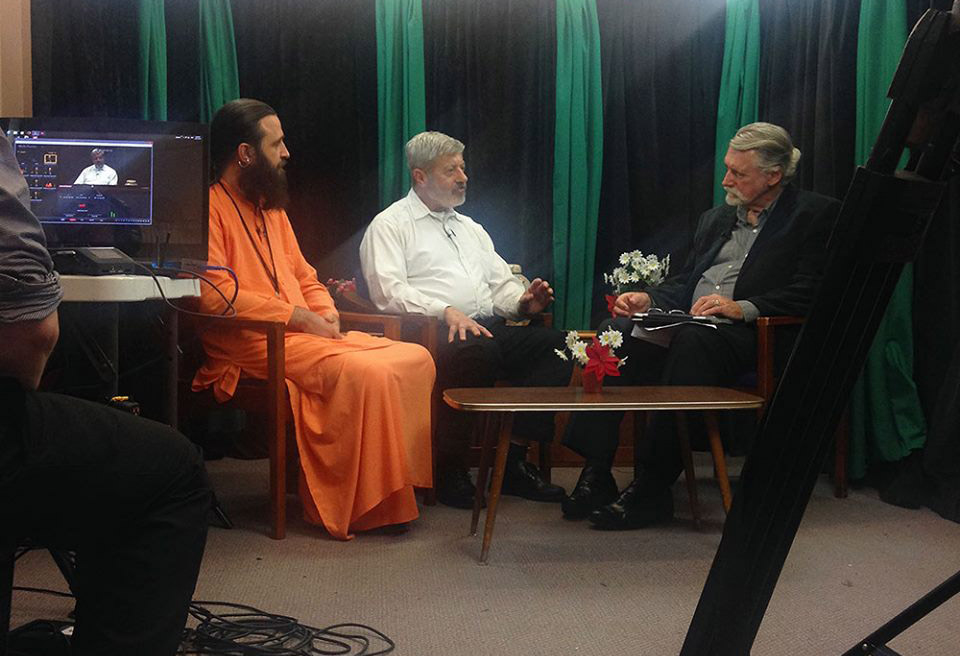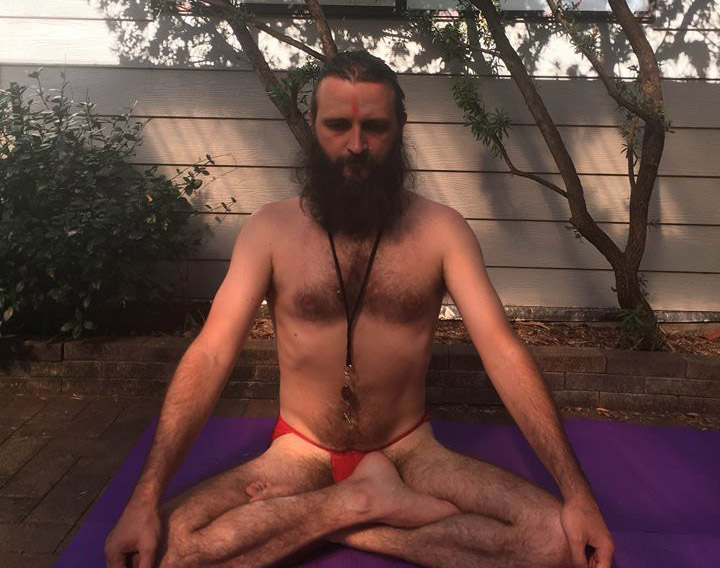This is one of the texts of Gorakshanath, written in a mixture of Hindi and dialects. For this version I used translations from Hindi. Of course, the text requires special verbal explanations of the meaning of the terms and how they all relate to each other. In such texts there are always a lot of symbolic images often used in meditation – the key focus of yoga. I want to draw your attention to the fact that the terms khecarī, bhūcarī, mahāmudrā are found in a variety of sources and in different contexts. Contrary to popular belief that among the Nāthas khecarī-mudrā is the practice of rolling the tongue back, this text confirms that, as in some tantric systems, in Nātha’s practice it may simply be a form of awareness. The same accounts to mahāmudrā, which isn’t described here as Haṭha-yoga technique of stretching one leg, regulating breathing, etc. The mahāmudrā in Buddhism is one of the highest states of consciousness, in this text the term is used in a very similar context. I used for translation a collection of texts published in the Gorakshanath Mandir in Gorakhpur, in addition to this, there are many other texts where you will find the names of mudrās similar to those found in various tantric traditions and their practices. But this is one of the illustrative examples that helps to expand the idea of seemingly “known practices” among “yoga teachers” in the West. Although in India there is a trend to limit variations of practices because of consumerism. But, the true seekers of the authentic state of yoga avoid the limited state and therefor modern artificial paths. For people who are curios and enthusiastic to expand their knowledge, I have translated this text into English.
रोमावली
Romavali (Hairline)
सत पिता रज मात्ता तम करि गाड़ी पाई,
Sattva is the father, rajas is the mother, tamas – decay.
लोह मास तुचा नाड़ी ये चारि धात माता की वोलिये,
Blood, muscles, skin, and veins are said to belong to the mother.
चीरज हाड गृद्र ये तीनि धात पिता की बोलिये,
Semen, bones, bone marrow, these three are said to belong to the father.
ए सप्त घात का शरीर बोलिये ।
These seven joined together are said to be the body.
द्वै हाथ द्वौ पैर छाती लिलाट घाट अष्टांग जोग बोलिये।
Two arms, two legs, two breasts, a torso, and a head, they are said to be the eightfold yoga.
बंद भेद मुद्रा तीन्यू साधंति ते सिधा बोलिये ।
Bandha, bhedana (piercing), mudrā (symbol of union), it is said that those who know these three are perfect (siddha).
कौंण बंधि बांधिये, कौंण भेद भेदिये, कौंण मुंद्रा मुंदिये ये बोलिये घट भीतरि । ते कौंण कौंण ।
What bandha (connection) should be connected? What bheda (penetration into the hidden) should be pierced? What mudrā (symbol of the Supreme) should be made a symbol of the Supreme?
मन बन्धि बांदिये पवन भेद भेदिये चिंद मुंद्रा सुंदिये।
The mind is a bandha (connecting), it must be bound (by the Supreme); pavan – the life force penetrating within – must be penetrated (by the Supreme); bindu (the essence of creation) is a symbol of the union mudrā, it must be in a symbolic union.
कौंण विमल बिचारै कौंण षिरे कौंण झरै।
Who is pure, who thinks? Who destroys? Who makes it rain?
मन विमल बिचारै सूरज षिरै चंद्र झरै ।
The mind is that pure one who is the basis of thinking, the Sun – who destroys, and the Moon – who sends rain.
हिंद पीर जिंद पीर ए बोलिये घट भीतरि | ते कौंण कौंण ।
Hindu pir (spiritual father), Muslim pir, they are said to be hidden within the body. Who are they?
हिंद पीर बोलिये मन, जिंद पीर बोलिये पवन ।
The Hindu pir (spiritual father) is said to be the mind, the Muslim spiritual father is said to be the pavan (vital force).
षेचरी भूचरी गुपत प्रगट । ते कौंण कौंण ।
Khecarī (moving in the sky) and Bhūcarī (moving on the earth) are hidden and manifested. Who are they?
षेचरी बोलिये मन, भूचरी बोलिये पवन ।
The mind, it must be said, is Khecarī, and the vital wind is Bhūcarī.
गुपत बोलिये ग्यांन, प्रगट बोलिये सरीर ।
Knowledge, let’s say, is that which is hidden, and the body is that which is manifested.
सरीरारथ परमारथ, गूढारथ । ते कौंण कौंण ।
The truth of the body, the highest truth of the body, the hidden truth, who are they?
सरीरारथ बोलिये सरीर भेद, परमारथ बोलिये प्रांण भेद, गूढारथ बोलिजै विचार ।
The truth of the body, it must be said, – what is realised within the body. The highest truth – what is realised within prāṇa. The hidden truth – what is in the investigation or vicāra.
चारी पीर बोलिजै घट भीतरि । ते कौंण कौंण ।
Please tell about the four masters within the body. Who are they?
मन मच्छिंद्र नाथ, पवन ईश्वर नाथ, चेतना चौरंगी नाथ, ग्यांन श्री गोरष नाथ,
Mind is Macchindranāth, vital force is Īśvaranāth, intellect is Caurangīnāth, and wisdom is Gorakṣanāth.
चारी तकबीर बोलिजै घट भीतरि। ते कौंण कौंण ।
Tell about four functions within our psychophysics. What are they?
दृष्टि कहै क्यूं लीजै दीजै, सुरति कहै क्यूं, बोलिये सुणिये, नासका कहै क्यूं सुगन्ध बास परमालादि लीजै, जिभ्या कहै क्यूं षाटी मीठी षाइये ।
Vision – which receives and projects; memory – which perceives speech and which allows to speak; nose – which catches aromas; tongue – which takes on pleasant tastes.
चारी दिसा बोलिये धन भीतरी । ते कौंण कौंण ।
Please tell about four sides within the body. What are they?
सबद बोलिये उत्तर, पवन बोलिये पछिम I दृष्टि बोलिये दषिण सुरति बोलिये पूरब ।
Speech “sabad”, I must say – the north; life force – west; south is sight, remembrance is east.
चारि आप कला बोलिये घट मीतरि | ते कौंण कौंण ।
Please tell about the four manifestations within the body. What are they?
ऊरम धूरम जोति ज्वाला |
This is a wave (of vibrations), smoky or atmospheric substance, light and fire.
ऊरम बोलिये मन, धूरम बोलिये पवन, जोति बोलिये नेत्र, ज्वाला बोलिये श्रवन |
The mind, it must be said, is the wave, the atmospheric substance is the life force,
the light is the eyes, hearing is the fire.
चारि षांणी बोलिजै घट मीतरि । ते कौंण कौंण ।
Tell about four forms within the body (evolutionary memory). What are they?
स्वेतरज अंडरज जेरज उदबीरज।
These are birth from sweat, birth from an egg, birth from a womb, and birth from a seed.
सेतरज बोलिये हाड़, जेरज वोलिये बीरज, अंडरज बोलिये नेत्र, उदबीरज बोलिये रोमावाली ।
Bones, it is said, are born from sweat, semen – from the womb,
eyes – from the egg, and hair – from seed.
चारि बांणीं बोलिये घट मीतरि ।ते कौंण कौंण ।
What are the four kinds of speech within the body?
सहज संजम सुपाइ अतीथ |
This is the one that is innate – “sahaja”; the one that is fully assembled – “saṃyama” (often interpreted as control); the speech that is “svayambhū” – manifested itself (anāhata), and transcendental.
सहज बोलिये सरीर, संजम बोलिये पवन, अतीत बोलिये परम पद ।
महा मुद्रा महां अजाच नग्री महां जोगणी स्वयंभू बोलिये ।
The body should be called “sahaja” (innate), the life force should be called “saṃyama”, the Supreme state should be called transcendental. The great symbol is “mahāmudrā”, the great abode without poverty, the great yogini – “svayambhū”.
जे बांणीं षांणी कौ बिचारैं ते निराकार बोलिये, ऊँकार मधे जोति जांणियै
ऊरम धूरम जोति ज्वाला । भेदौ रवि का चारयूं कला ।
Those who meditate on these categories of speech should be called unmanifested. You must know that there is light within Omkara. There is a wave (of vibration), atmosphere, light, and fire. Penetrate the four manifestations of the Sun.
मन करि हस्ती बिमल जल पीवै । द्वै पष चीन्है तौ सोलह कला जीवै।
बारह कला सूरज, सोलह कला चंद।
The elephant of mind drinks pure water. Comprehend both poles of life in sixteen manifestations (it is likely said about tithi and two pakṣas). Sun has twelve manifestations and Moon has sixteen.
गुरू जिसका लषावै नहीं चेला तिसका अंध ।
बारह कला सूरज की, ताकौ गुण घट भीतरि ब्यापै । ते कौंण कौंण ।
If the Guru shows nothing, then the disciple is blind. Sun has twelve manifestations and they permeate the body. What are they?
चिंता, तरंग , डयम, माया, परग्रहणै, परपंच , हेत , बुधि ।
काम, क्रोध, लोभ; दृष्टि ये बारह कला सूरज की बोलिये ।
Anxiety (various thoughts), fluctuation, involvement in manifestations, capture by the external, phenomenality, motivation, wakefulness, passion, anger, greed, perception of the visible. These are the twelve aspects of Surya.
सोलह कला चंद्रमा की ताकै गुण घट भीतरी राषैं | ते कौंण कौंण ।
There are also sixteen manifestations of the Moon, permeating the whole body within. What are they?
सांति, नृवर्त, क्षिमा, नृमल, निहचल, ग्यांन, सरूप, पद,
नृबांण, नृबिष, निरंजन, अहार , निद्रा, मैथुन, बाई, अमृंत
ये सोलह कला चन्द्रमा की बोलिये।
Peace, detachment from mundane, patience, purity, stability, wisdom, perfect form, perfect state, nirvāṇa (silence of worldly aspirations), fearlessness, spotlessness, satiety, rest (sleep), intercourse, breath, elixir. These are the sixteen aspects of Moon.
ए चारि कला सूरज की साधै तो सोलह कला चंद्रमा की पावै।
Those who are masters of the manifestations of Sun, they will attain the sixteen manifestations of Moon.
एती एक रोमावली ग्रंथ जोग कथितं श्री गोरषनाथ ।
Gorakshanath explained the book on yoga called “Romāvalī” (Hairline).








